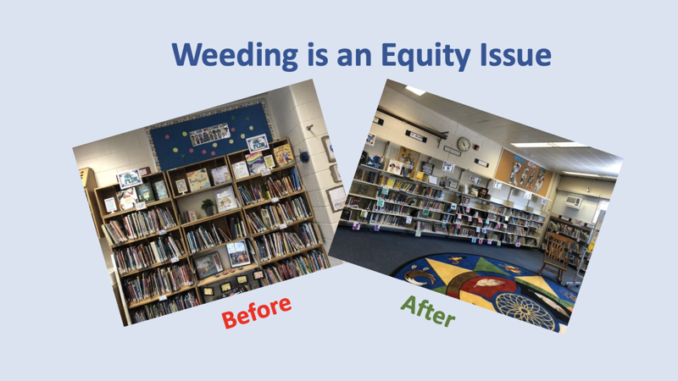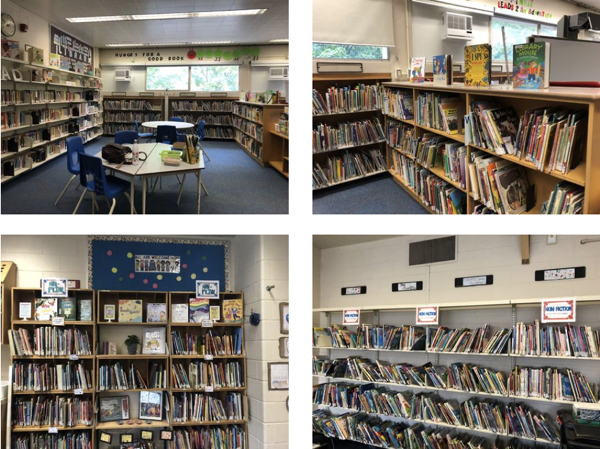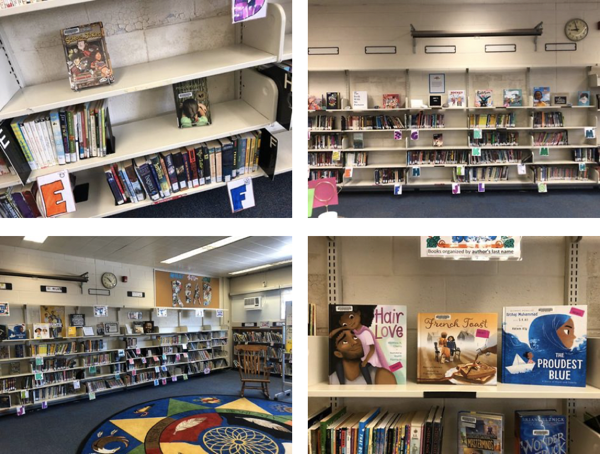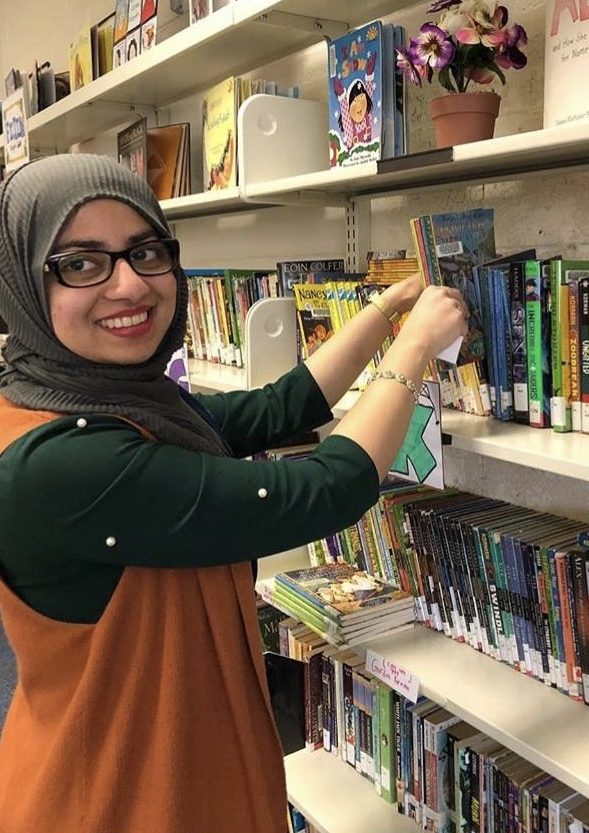
By Rabia Khokhar
The school library learning commons (SLLC) is an important space in a school community. It is the ‘heart’ that connects students, teachers and other community members in many different ways. Therefore, the SLLC must always strive to be a space that is relevant, responsive and evolving so that it can represent, affirm and authentically teach students about diverse identities and lived experiences in their local, broader and global communicates.
As a former teacher-librarian (and of course one always in my heart), I recognize the positional power and platform the SLLC has in a school community. It is a space that can really model and intentionally embed equity within its structure and practices through the design of the space, collaboration with students and teachers and book collections.
I had the opportunity to be a long term teacher-librarian (LTO) for two consecutive years at a downtown Toronto school community and support the transition of our school library into a library learning commons. My principal and I had a shared vision of the library space that supported the centering of culturally responsive and relevant resources, fostering a love of reading, supporting critical consciousness, building student independence and ensuring accessibility. Both of us were new to the school community and so we took the time to observe and learn about the library space we were inheriting. Through our observations we recognized that one of the goals we wanted to focus on was to update and weed our print collection. We hoped that this would be an impactful way to carry forward our shared vision of our school library as an equitable learning space for our school community. This reflection will share some of my experiences, observations and insights I learned as I engaged in the process of weeding our print collection over the span of two years.
One of our goals for our SLLC was to weed and update our print collection. To begin this work, I did an initial assessment of our collection by scanning and checking out each of our sections briefly. It became sort of like a walk around the SLLC with a critical eye. During this initial scan, I checked to see the types of books we had, some copyright dates, which books were being taken out, which areas were high traffic areas for our students and teachers and if our collection was aligned to curriculum areas. I also observed how the library was being used and if it was accessible for our Kindergarten to grade six students. After this initial scanning, observations and assessments, I was beginning to build the context and ‘story’ of our SLLC. I then researched our entire collection and its age through our school board’s library database to learn the details.
This initial scan and assessment helped me learn the context and background of our school library. I further learned that our SLLC had not been thoroughly and intentionally weeded for many years because there had not been a consistent teacher-librarian in the role. Through further ongoing and detailed observations, I also learned that our fiction and non-fiction shelves were packed and full and so it was hard for our students to even see the books we had. It was not accessible for them. Having this many books on our shelves was actually a disservice to our students. In our fiction collection, many of the books packed on the shelves were yellowing with age, were outdated and older than me and there were multiple copies of some that were not of interest for my students. I noticed that many of the students were only engaging in books in a specific area or taking out the same ones probably because the packed shelves made it hard to see what we actually had available. In our non-fiction collection, many of the books were outdated and perpetuated stereotypical and misrepresentation of communities and identities.

Through these assessments, what was affirming to hear and see was the students’ continued love for the SLLC. It motivated me to continue learning and working collaboratively to redesign a space with a collection that was relevant, up to date and easily accessible for my students. However, truthfully the task that lay ahead was overwhelming as a new teacher-librarian. But this work was essential if we wanted to strive to ensure our SLLC became responsive and relevant.
In her article, “Crying Over Spilled Milk” (2005) Gail Dickinson says “weeding is the ongoing process of removing resources from the collection”. It is a process that is a part of the teacher-librarian’s professional practice and responsibility and it should be habitual and systemic in nature. It is an equity issue because in the SLLC, equity is really thinking critically about representation, power, identities, intersectionalities and investigating whose stories have always been centered and whose experiences are missing, erased. I came to firmly believe that intentional and thorough weeding is necessary if we are striving to create an equitable SLLC. This lens is focused on centering diverse voices and working to share a complete, authentic, dynamic story, events and histories. It is a way to ensure our collection is relevant, responsive and evolving with our students and the times.
As the process of weeding began, with conversations, support and encouragement from my principal and my school board’s library coordinator and services I recognized that if we wanted to begin making a difference, we would need to target specific sections and prioritize. By specifically focusing on section we would be able to make this enormous, messy and ongoing task manageable. Therefore, in Year 1 of my LTO, we decided to focus on the Fiction section and in Year 2 we embarked on our non-fiction collection. I learned that to make the task accessible with various other teacher-librarian responsibilities, I needed to further divide it. Therefore, I targeted specific sections of our collection and set a goal to weed them by the end of the week. For example, during one week I decided to go through the picture book sections A and B.

Below are some of the questions, thoughts, actions and considerations I engaged with as I weeded out fiction and non-fiction collections.
Weeding Fiction and Non-fiction Books: Questions/ Considerations:
- Quick scan of the section you are weeding
- Consider how this section and then this particular book fits or does not fit into the complete section
- Consider the book itself. What type of shape is it in? Is it yellowing? Are there multiple copies? Are multiple copies needed? We found that many chapter books that were not really of interest for our students had multiple copies that were taking up a lot of space on the shelves.
- Check the copyright date on the book
- Check to see if the book is relevant, connected to curriculum
- Check to see if this is a high demand and popular book
- Does the book have any stereotypes, misinformation in its illustrations and text?
- Who is the author of the story? Who is the illustrator of the story?
- Does this fit into our entire collection? How does it fit into our SLLC?
- Is there another more current and relevant book that can do a better job in delivering the message of the book?
- When I look through my entire collection through an inclusive lens whose perspective is there? Whose is missing?
- When I look through my entire collection through an equity lens whose story and perspective has historically been centered? Who has told this story and information?
- How are people represented? Communities ‘positioned’ and which ‘gaze’ is the text from?
- Does this book engage in cultural appropriation or show people as ‘different’, ‘exotic’ or through a deficit lens?
- Is the information accurate?
- Will my students enjoy this story? Is it relevant for their lived experiences? Does it teach them authentically about diverse lived experiences?
- Are there students who enjoy this book and ‘need’ it in our school library?
- Is this book connected to the curriculum? How?
- Are teachers using this resource?
- Why this book in our library for our students during this time?
It took an entire school year to weed the fiction section. As I reflect, it was often overwhelming and messy but it got easier and more habitual and systemic as I engaged with the work. The first few times when I took a book off the shelves and placed it into the box, I felt nervous and wondered if I was even qualified to do this. Over time, I learned to trust the criteria I was developing as I was doing the work. What also supported me during this work was remembering the vision of our SLLC and all we wanted to strive it to be for our students. I was learning that a SLLC that was intentionally and systemically being weeded would allow space for relevant and responsive books for our students. It would ensure that our shelves were not packed and so would allow for accessibility and user independence. The hope and passion for what this space could be really was a source of motivation. Documenting the process was another strategy that supported the work because it allowed me to reflect, ask questions, record and come back to this work with fresh eyes. It was a way to see what we had accomplished and also all that still needed to be done. It was also a way to advocate for our SLLC and the amount of work that goes into creating and sustaining such a space.

As a new racialized teacher-librarian, having my principal’s support meant the world. He supported, encouraged and advocated for this work. His support was helpful because he believed in my skills but also reinforced to our school community that this was a part of a teacher-librarian’s responsibility and duty. The message that older books were being removed to create space for relevant and high quality new books was important since many of us have an emotional attachment to them. My principal was able to firmly communicate that the books we were removing could not be sent elsewhere: if they were outdated for us then they were not good resources for others. Having support from the administrator really made me begin to feel confident about the work that was happening in our SLLC. It reminded me of our shared vision and hope for what this space could be.
One very important lesson I learned was that weeding should be systemic and ongoing. It is important that weeding becomes something that is continuous. It can become difficult if it becomes a big event where there are many changes that take place. Although, in my SLLC’s situation, to some degree it did become an event because of our context and history.
One of the most profound moments was when we were weeding our collection and there were significant changes taking place in our SLLC, our students responded very positively. They were interested, engaged and excited about the new books that we were displaying. But I think they were also excited to actually browse independently. The shelves were less packed and there was space for students to explore our collection. There was almost a renewed sense of interest, excitement and request for books. There was also finally room for displays which really supported our students as they continued their work towards becoming critically conscious members of their communities. It was a privilege and an honour to witness this and see our student’s excitement and engagement.
As I reflect on our SLLC’s journey, I have come to believe that weeding our collection is an equity issue and if done intentionally and thoroughly is an act of justice. It is about taking actions to think critically about the stories and authors who have always been centered and moving towards creating space for multiple perspectives, own voices and responsiveness. There is much work left to do but the amount that we were able to do would not have been possible without the community support from my principal, my school board’s library coordinator and support staff, Canadian School libraries Journal, lots of tweets and social media posts.
As a new teacher-librarian, it was an honour to support this work in the SLLC. I firmly believe that school library learning commons are transformation spaces in a school community and weeding our collection is an important way we can continue to ensure they are current, evolving and ‘human’ centered.
Reference
Dickinson, G. (2005). Crying Over Spilled Milk. Library Media Connection 23(7).

Rabia Khokhar is a teacher with the Toronto District School Board. Currently, she is an ESL Resource teacher at Davisville Junior Public School. She is passionate about ensuring schools are inclusive spaces where all students with their multiple and intersectional identities are reflected, represented, included and seen through an asset based lens. Rabia believes one of the main goals of schools is to help students become critically conscious members of their communities. She is a strong advocate for the school library and believes it plays a central role in raising students who are critical thinkers and committed to issues around equity and justice.